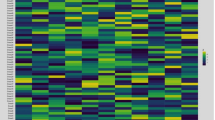Abstract
This study was the only report for exploiting gynoecy for studying combining ability and hybrid development in bitter gourd. Thirty-six F1 hybrids and nine inbred lines including one gynoecious line were used to assess combining ability for earliness and yield in bitter gourd Momordica charantia L.). Among parents, gynoecious parent; DBGy-201 showed maximum GCA effect in desirable direction for node to first female flower, days to first picking, numbers of fruits and yield per plant. The parent, P6 (Priya) exhibited highest GCA effect for fruit length, weight and diameter. These parents were good general combiners for yield and earliness and could be used to improve these traits in bitter gourd breeding programmes for the accumulation of favourable genes. The parent P1 (DBGy-201) also exhibited earliest in per se performance with first female flower at ~7th node and the gynoecious hybrids DBGy-201 × Pusa Vishesh and DBGy-201 × Pusa Do Mausami had female flower at lower node (~8th node). The best gynoecious hybrids were DBGy-201 × Priya for numbers of fruits per plant and DBGy-201 × NDBT-12 for fruit yield per plant. The findings of second experiment (i.e. Line × Tester mating design) confirmed the potentiality of gynoeciuos × monoeciuos hybrids for high yield and earliness. The gynoecious inbred, DBGy-201 showed maximum GCA effect in desirable direction for node to first female flower, days to first picking, numbers of fruits and yield per plant and additive gene action is more important for breeding by selection.
Similar content being viewed by others
References
Behera TK (2004) Heterosis in bitter gourd. In: Singh PK, Dasgupta SK, Tripathi SK (eds) Hybrid vegetable development. The Haworth Press, New York, pp 217–221
Behera TK, Dey SS, Sirohi PS (2006) ‘DBGy-201’ and ‘DBGy-202’:two gynoecious lines in bitter gourd (Momordica charantia L.) isolated from indigenous source. Indian J Genet 66:61–62
Behera TK, Gaikwad AB, Singh AK, Staub JE (2008) Comparative analysis of genetic diversity in Indian bitter gourd (Momordica charantia L.) using RAPD and ISSR markers for developing crop improvement strategies. Sci Hortic 115:209–217
Behera TK, Dey SS, Munshi AD, Gaikwad AB, Pal A, Singh I (2009) Sex inheritance and development of gynoecious hybrids in bitter gourd (Momordica charantia L.). Sci Hortic 120:130–133
Cantliffe DJ (1977) Nitrogen fertilization requirements of pickling cucumbers grown for once-over mechanical harvest I. Effect of yield and quality. J Am Soc Hortic Sci 102:112–114
Chakravarty HL (1990) Cucurbits of India and their role in the development of vegetable crops. In: Bates DM, Robinson RW, Jeffrey C (eds) Biology and utilization of cucurbitaceae. Cornell University Press, Ithaca, pp 325–334
Christie BR, Shattuck VI (1992) The diallel cross: design, analysis and use for plant breeding. Plant Breed Rev 9:9–36
Cramer CS, Wehner TC (1998) Fruit yield and yield component means and correlations of four slicing cucumber populations improved through six to ten cycles of recurrent selection. J Am Soc Hortic Sci 123:388–395
Cramer CS, Wehner TC (2000) Path analysis of the correlation between fruit number and plant traits of cucumber populations. HortScience 35:708–711
Dey SS, Behera TK, Pal A, Munshi AD (2005) Correlation and path coefficient analysis in bitter gourd (Momordica charantia L.). Veg Sci 32:173–176
Dijkhuizen A, Staub JE (2002) QTL conditioning yield and fruit quality traits in cucumber (Cucumis sativus L.): effects of environment and genetic background. J New Seeds 4:1–30
Fan Z, Robbins MD, Staub JE (2006) Population development by phenotypic selection with subsequent marker-assisted selection for line extraction in cucumber (Cucumis sativus L.). Theor Appl Genet 112:843–855
Fazio G (2001) Comparative study of marker-assisted and phenotypic selection and genetic analysis of yield components in cucumber. PhD dissertation, University of Wisconsin, Madison, USA
Franco MC, Cassini ST, Oliveiria VR, Vieira C, Tsai SM, Cruz CD (2001) Combining ability for nodulation in common bean (Phaseolus vulgaris L.) genotypes from Andean and Middle American gene pools. Euphytica 118:265–270
Griffing JB (1956) Concept of general and specific combining ability in relation to diallel cropping systems. Aust J Biol Sci 9:463–493
Iwamoto E, Ishida T (2006) Development of gynoecious inbred line in balsam pear (Momordica charantia L.). Hort Res (Japan) 5:101–104
Jeffrey C (1980) A review of the cucurbitaceae. Bot J Linn Soc 81:233–247
Kennedy RR (1994) Line × tester analysis in bitter gourd (Momoridica charantia L.). MSc dissertation, Tamil Nadu Agricultural University, Coimbatore, India
Khattra AS, Singh NJ, Thakur JC (1994) Heterosis and correlation studies in bitter gourd. Veg Sci 21:158–162
Mishra HN, Mishra RS, Mishra SN, Parhi G (1994) Heterosis and combining ability in bittergourd (Momordica charantia). Ind J Agric Sci 64:310–313
Munshi AD, Sirohi PS (1993) Studies on heterosis in bitter gourd (Momordica charantia L.). Veg Sci 20:147–151
Ram D, Kumar S, Banerjee MK, Singh B, Singh S (2002) Developing bitter gourd (Momordica charantia L.) populations with very high proportion of pistillate flowers. Cucurbit Genet Coop Report 25:65–66
Ram D, Kumar S, Singh M, Rai M, Kalloo G (2006) Inheritance of gynoecism in bitter gourd (Momordica charantia L.). J Hered 97:294–295
Singh RK, Chaudhary BD (1979) Biometrical methods in quantitative genetic analysis. Kalyani Publishing, New Delhi, India
Singh SK, Ram HH, Singh JP (2004) Combining ability in bitter gourd (Momordica charantia L.). Prog Hortic 36:107–112
Sirohi PS, Choudhury B (1978) Heterosis is bitter gourd (Momordica charantia L.). Veg Sci 6:106–112
Zhou WB, Lou S, Luo JN (1998) An early maturing and high yielding bitter gourd hybrid Cuilli No. 1. Plant Breed Abstr 68:1002
Author information
Authors and Affiliations
Corresponding author
Rights and permissions
About this article
Cite this article
Dey, S.S., Behera, T.K., Munshi, A.D. et al. Gynoecious inbred with better combining ability improves yield and earliness in bitter gourd (Momordica charantia L.). Euphytica 173, 37–47 (2010). https://doi.org/10.1007/s10681-009-0097-z
Received:
Accepted:
Published:
Issue Date:
DOI: https://doi.org/10.1007/s10681-009-0097-z



